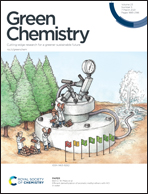Modification of cellulose through physisorption of cationic bio-based nanolatexes – comparing emulsion polymerization and RAFT-mediated polymerization-induced self-assembly†
Abstract
The polymerization of a bio-based terpene-derived monomer, sobrerol methacrylate (SobMA), was evaluated in the design of polymeric nanoparticles (nanolatexes). Their synthesis was accomplished by using emulsion polymerization, either by free-radical polymerization in the presence of a cationic surfactant or a cationic macroRAFT agent by employing RAFT-mediated polymerization-induced self-assembly (PISA). By tuning the length of the hydrophobic polymer, it was possible to control the nanoparticle size between 70 and 110 nm. The average size of the latexes in both wet and dry state were investigated by microscopy imaging and dynamic light scattering (DLS). Additionally, SobMA was successfully copolymerized with butyl methacrylate (BMA) targeting soft-core nanolatexes. The comparison of the kinetic profile of the cationically stabilized nanolatexes highlighted the differences of both processes. The SobMA-based nanolatexes yielded high Tg ∼ 120 °C, while the copolymer sample exhibited a lower Tg ∼ 50 °C, as assessed by Differential Scanning Calorimetry (DSC). Thereafter, the nanolatexes were adsorbed onto cellulose (filter paper), where they were annealed at elevated temperatures to result in polymeric coatings. Their morphologies were analysed by Field Emission Scanning Electron Microscopy (FE-SEM) and compared to a commercial sulfate polystyrene latex (PS latex). By microscopic investigation the film formation mechanism could be unravelled. Water contact angle (CA) measurements verified the transition from a hydrophilic to a hydrophobic surface after film formation had occured. The obtained results are promising for the toolbox of bio–based building blocks, focused on sobrerol-based monomers, to be used in emulsion polymerizations either for tailored PISA–latexes or facile conventional latex formation, in order to replace methyl methacrylate or other high Tg-monomers.



 Please wait while we load your content...
Please wait while we load your content...